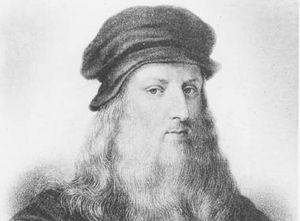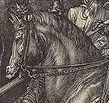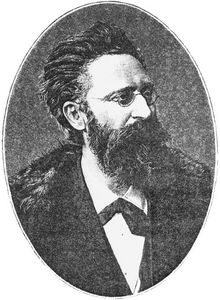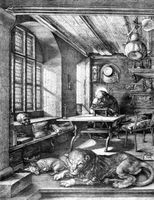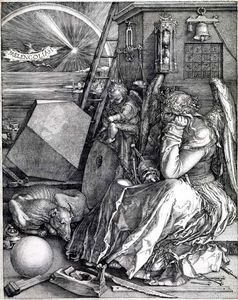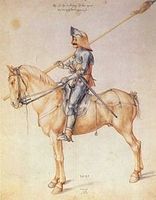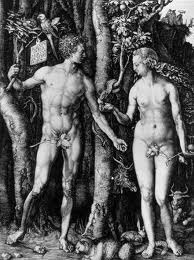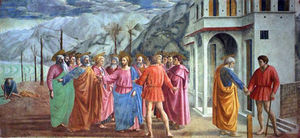Albrecht Durer Knight Death and the Devil
Knight Death and the Devil
- Date of Creation:
- 1513
- Height (cm):
- 24.forty
- Length (cm):
- nineteen.10
- Created by:
- Knight Death and the Devil Page'due south Content
- Story / Theme
- Inspirations for the Work
- Assay
- Critical Reception
- Related Paintings
- Locations Through Fourth dimension - Notable Sales
- Artist
- Art Period
- Bibliography
From 1512 to 1520 Albrecht Durer began to explore the deep recesses of Classical artifact, drawing on his time spent in Italy. The Knight, Death and the Devil copper engraving was one of three works he produced that are still widely regarded today as his 'Principal Engravings'.
Knight, Death and the Devil was among the first of these master works ((meisterstiche), and together with St. Jerome in His Study and Melencolia I, information technology was based on Durer'south dear and appreciation of humanist writer Cornelius Agrippa who divers mood disorder into 3 categories: morality, theologically and intellectually. Durer's engraving reflect that respectively.
Death is portrayed every bit property an hourglass and with the mythical crown of serpents but as he touches the armor of the Knight the latter is undeterred past Death'southward presence. Whilst his time has almost past the Knight remains unshaken and his dog runs through to protect his master from the Devil.
Created in his workshop when he had returned from his 2d trip to Italy in 1507, these masterworks were preceded by some of his best-known paintings, including Adam and Eve and Assumption of the Virgin.
Durer had indulged himself in the work of Leonardo da Vinci and this is where the proportions for the horse come up into play.
Knight, Death and the Devil is likely to have been inspired by the Bible and biblical preaching as the engraving is of a Christian knight riding through a forest flanked by both the devil and death.
Created in a Gothic way, the landscape is Nordic and dour and this is believed to be partly due to Durer'south familiarity with Desiderius Erasmus's 'Enchiridion militis Christiani' which translates as the 'Handbook of a Christian soldier'.
Erasmus was a theologian and humanist from the Netherlands and was in his early on 40s when this engraving was created. Philosophical past nature he had published the book some x years before and it was one of the fundamental things that the Dutchman is remembered for. The plot of the story is an appeal to Christians to act and remember their faith during life.
Albrecht Durer'south evident interest in the works of humanist Cornelius Agrippa was a key inspiration in all three of his copper engravings and this was the piece that reflected the morality of life.
Technique:
To produce Knight, Expiry and the Devil Durer would have used a burin, which is a very sharp tool, held in his palm to push through the copper plate. Twisting away the copper y'all can run into how the lines that are engraved testify idiosyncrasies that allows them to be distinguished between drypoint and etched lines.
Using the burin is good for introducing stabs of triangular characteristics to the work and this is particularly evident in the helmet of the Knight.
One of the most skilled artists of the Renaissance, Durer had a sophisticated bear upon and looking at the equus caballus'south neck shape information technology is articulate how he used engraved lines in a like style to topological maps when describing forms.
Features:
The artist'due south horse is a feature of the work that shows a link to da Vinci and is a reflection on both the flow and Durer's huge interest in beefcake and natural sciences. The trunk is masterfully rendered by geometric shapes to create a powerful image of the beast.
Texture:
The surfaces and textures in this engraving are both astounding and finished to perfection. There is a articulate distinction between the Knight's armor, his leather kick, the fur of the domestic dog and the horse - showcasing Durer'due south brilliance in this medium.
Class:
Using a Gothic style the whole engraving takes many forms that effortlessly blend to one another. The horse was created using multiple interlocking curves and also the chin of the Knight is woven in line with his helmet.
Signature:
Knight, Death and the Devil is signed and dated by Albrecht Durer and at the lesser left of the work was the inscription 'S. 1513'.
A huge artist at this time, Durer'southward maturity and impeccable work was clear for all to run across and his reputation soared across Europe.
Knight Death and the Devil was part of the trio that he created in order to earn more money and copies were sent to many illustrators, artists and engravers, and this shows the positive reception he received.
Knight Death and the Devil is a clever piece of work of emblematic composition and art historian Raymond Stites states that Durer had a "tangible idea in a world of changing forms. " By this he was referring to the dissimilarity of the Knight and his horse.
Interpretations of this work have been wide and varied but 19th century Austrian art historian Moritz Thausing believes the design illustrates the 'four temperaments'. Thausing argues that Knight, Decease and the Devil represents sanguinity, which is an extroverted personality.
Near art critics hold that this engraving is a celebration of the Christian organized religion and also the show of the upsurge in Humanism at this fourth dimension beyond northern Europe which was kicking-started by Durer following his trips to the Renaissance capital of Italy.
Sten Karling, a mid-to-belatedly 1900s writer and annotator has a somewhat different view. He claims that instead of the Knight showing celebrity information technology did, in fact, depict a 'robber baron'. By this Karling was proverb that due to a significant lack of religious and Christian symbols, Knight, Death and the Devil could not possibly be based on the Bible.
Similarly, the fox has its tail wrapped effectually the lance of the Knight and in Greek legend this is a symbol of five things; Greed, Cunning, Treachery, Lust or Whoring.
The original Knight, Death and the Devil no longer survives but there are copies in many major museums and galleries including the Museum of Modern Art, New York and the British Museum, London.
In 1513 Albrecht Durer was 42 years old and working in his workshop in Nuremberg. He was a mature artist with an indisputed reputation across Europe. He produced Knight, Death and the Devil having recently returned from his 2d trip to Italy.
Inspired by Giovanni Bellini, Leonardo da Vinci and Raphael Durer began to brand copper engravings, claiming that painting just didn't bring in enough money.
Knight, Death and the Devil was created in the showtime quarter of the 16th century as the Renaissance was in total period beyond Europe. New techniques including proportion and linear perspective had been developed.
Taking ideas for his engravings from the works of Plato also as various personality traits and other sources, Knight, Death and the Devil was the kickoff copper engraving Durer created and information technology was copied and published beyond Europe making huge waves in the art world.
To read more virtually Albrecht Durer please choose from the following recommended sources.
• Bartrum, Giulia. Albrecht Dürer and his Legacy. British Museum Press, 2002
• Berger, John. Albrecht Durer: Watercolours and drawings. Taschen, 1994
• Durer, A. & Kurth, Due west. Complete Woodcuts. Dover Publications Inc. , 2000
• Durer, Albrecht. The Drawings. Dover Publications Inc. , 1970
• Heaton, Mary Margaret. The History of the Life of Albrecht Dürer of Nürnberg: With a translation of his letters and journal, and some account of his works. Determined Media Corporation, 2005
• Panofsky, E. The Life and Art of Albrecht Durer (Princeton Archetype Editions). Princeton University Press, 2005
• Wolf, Norbert. Albrecht Durer. Prestel, 2010
Albrecht Durer Knight Death and the Devil
Posted by: webblity1947.blogspot.com


